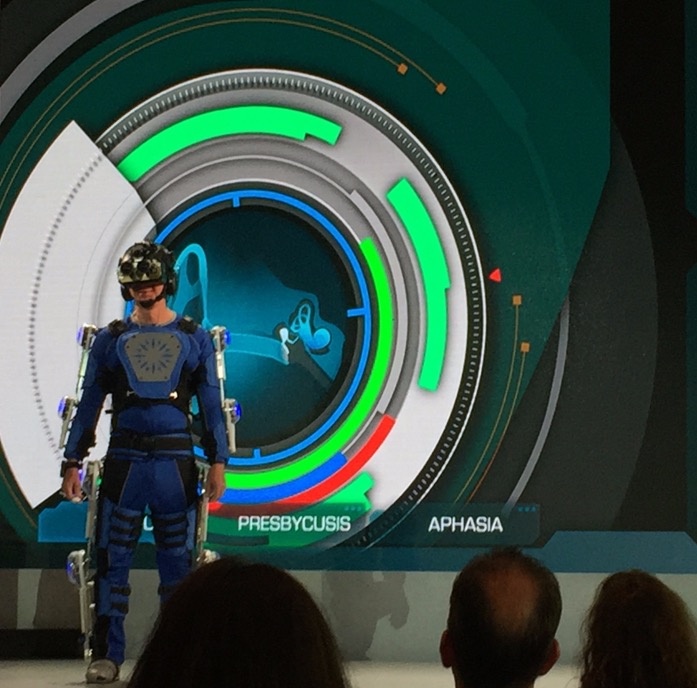
By Doug Stephens
At an investor conference in March of this year, Macy’s CEO Terry Lundgren stated that while Amazon may be a threat in apparel sales, it was likely ill-prepared to deal with the realities of online apparel logistics. Amazon, Lundgren believes, will soon encounter inevitable challenges in dealing with online returns, pointing to Macy’s experience as evidence to support his point. The statement was made in response to a recent report from Cowen Research predicting that Amazon would surpass Macy’s as America’s top apparel seller by 2017 which, by the way, appears likely to happen.

Amazon CEO Jeff Bezos wears a robot costume at a covert technology conference
Around the same time that Lundgren was making these comments, however, Amazon was dealing with a different reality. Jeff Bezos was holding a covert, invitation-only conference on robotics, artificial intelligence and space exploration with some of the world’s leading experts in each field. While the details of what was discussed at the conference remain unknown, it’s safe to assume that it wasn’t about how to best clear out last season’s ladies wear collection. In fact, the closest thing to a fashion statement occurred when Jeff Bezos arrived wearing a robot costume!
So while Terry Lundgren was ruminating about inventory management and store operations, Jeff Bezos was off discussing manned commercial space flight, cyborgs and cognitive computing.
This stark contrast between the headspace of Amazon and its conventional rivals highlights precisely why using conventional retail industry calculus to analyze or compete against Amazon is fruitless. Amazon doesn’t think like a retailer – something that has won it both kudos and criticism from analysts and investors alike. And the reality is that while Amazon may be one of the world’s most successful online stores, it isn’t a retailer in the conventional sense. It is perhaps more appropriate to think of Amazon as a data, technology and innovation company that also happens to sell things. Consider that in the last year alone the company has launched an array of products, programs and platforms, almost none of which one would expect to see coming from a “retail” company.
For example:
- Dash Replenishment Services (DRS) – a replenishment ordering platform made possible by incorporating Wi-Fi enabled sensors directly into products. Beginning with Brita water filters, the company is working to broaden its penetration into other products and categories, setting up a network of devices that automatically generate orders for Amazon products and supplies.
- Amazon Echo is a Siri-esque device that can be used in the home and will assist with everything from ordering diapers or checking the score in the football game to playing music or finding a recipe . The device is always awake and listening for commands and requests that may include web searches, connected home commands or simple shopping requests. Apple co-founder Steve Wozniak went so far as to say that Echo is likely to be the ” next big platform for the near future…” Put a different way, if Amazon is heroin, Echo is the gateway drug. Echo’s launch was quickly followed up with two additional devices; the Echo Dot and Amazon Tap. In addition to becoming a conduit for product sales, these devices also promise an unprecedented data stream of consumer and household analytics.
- Flex – a courier service comprised of on-demand drivers looking to make between $18-25 per hour. For now the service is aimed solely at delivering Amazon packages to Amazon Prime subscribers. The program, if successful, will give Amazon another tool with which to improve last mile delivery logistics.
- Physical stores – the first of which was built in Seattle, are yet another new front for Amazon, with more stores being planned – hundreds more by some accounts. While the core product in these stores is books, I regard them more as Trojan horses offering two far more important things; the first being physical displays of key Amazon devices like Echo and Kindle Fire, giving customers an all-important chance to interact and play with them. Secondly, distribution and return points for online orders, potentially fractionalizing the company’s overall shipping costs in the long-term. They also serve as a working prototype for what retail stores of the future might look like, which may be why Amazon filed this patent last year, giving some insight into how the Amazon store of the future store might operate.
- Private label apparel brands were rolled out recently, following a growing pattern where Amazon quietly observes data on what third-party products sell particularly well on its site and then enters the category with its own branded products, such as baby wipes, phone chargers, Bluetooth speakers and more.
- Style Code Live – a live QVC-like television show designed to showcase Amazon apparel products, along with style tips and trends.
- Prime Now, which began as Amazon’s proprietary one-hour delivery service for products, was then expanded to include restaurant meals and now groceries.
A Network Not An Empire
What’s particularly fascinating about all of these innovations is that, as with Amazon Web Services – Amazon’s most profitable business division – each has the potential to generate revenue (over and above simply selling Amazon products) by becoming a service platform to other businesses. If Amazon for example is able to build a best-in-class, on-demand courier network for its own parcels, there’s little to stop it from opening the service up to other companies. Or if its Style Code Live show is a hit, there’s no reason that it couldn’t become a paid marketing platform for products outside Amazon’s assortment. In other words, every innovation that Amazon brings to the market becomes yet another node in their network. Unlike Macy’s, Walmart or Target, Amazon is not an industrially formed empire so much as a digitally developed ecosystem aimed at ultimately connecting everyone, everywhere to everything.
Jeff Bezos once said “Often times invention requires a long-term willingness to be misunderstood.” When retail CEO’s attempt to assign conventional industry logic or boundaries to Amazon they are playing directly into Bezos’ narrative and it’s a mistake that may cost them dearly.
What Terry Lundgren and many of his retail colleagues see as the unyielding constraints, limitations and realities of operating a retail company, Amazon sees as nothing more than archaic speed bumps in the road to becoming the central network to everything in a consumer’s life. Rather than adhering helplessly to the rules of a centuries old industry, Amazon instead appears more intent on reinventing the industry itself.

